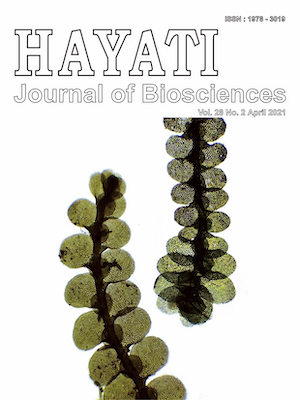The Development of In Vitro Culture Sterilization Method of Gametophyte Explant Lopholejeunea sp.
Abstract
In vitro cultures of leafy liverworts are still facing significant challenges due to high-level of explant contamination. The sterilization process can easily damage the structure of liverwort after exposure to the disinfectant. This study was to determine the concentration and time exposure of commercial bleach as a disinfectant to suppress contamination using the gametophyte culture of Lopholejeunea sp. The experiment consisted of control and six treatment combinations of commercial bleach with concentration 0.5, 0.75, and 1% (v/v), and exposure time (60 and 90 seconds). The type and location of contamination, the color of the explants after sterilization, and response after 30 days were observed. The results showed that the 0.75% bleach with 60 and 90 seconds exposure time had a lower contamination until the 7th day of culture. The most common type of contamination is bacteria and fungi that arise from the explant. Despite the contamination, it did not inhibit shoot formation. Further studies still needed to determine the type of fungicides and antibiotics with the most potent concentration and exposure time should be tested to obtain an axenic and viable culture of liverworts Lopholejeunea sp.
Downloads
HAYATI J Biosci is an open access journal and the article's license is CC-BY-NC. This license lets others distribute, remix, tweak, and build upon author's work, as long as they credit the original creation. Authors retain copyright and grant the journal/publisher non exclusive publishing rights with the work simultaneously licensed under a https://creativecommons.org/
























.png) IPB University
IPB University Department of Biology
Department of Biology The Indonesian Biological Society
The Indonesian Biological Society 

